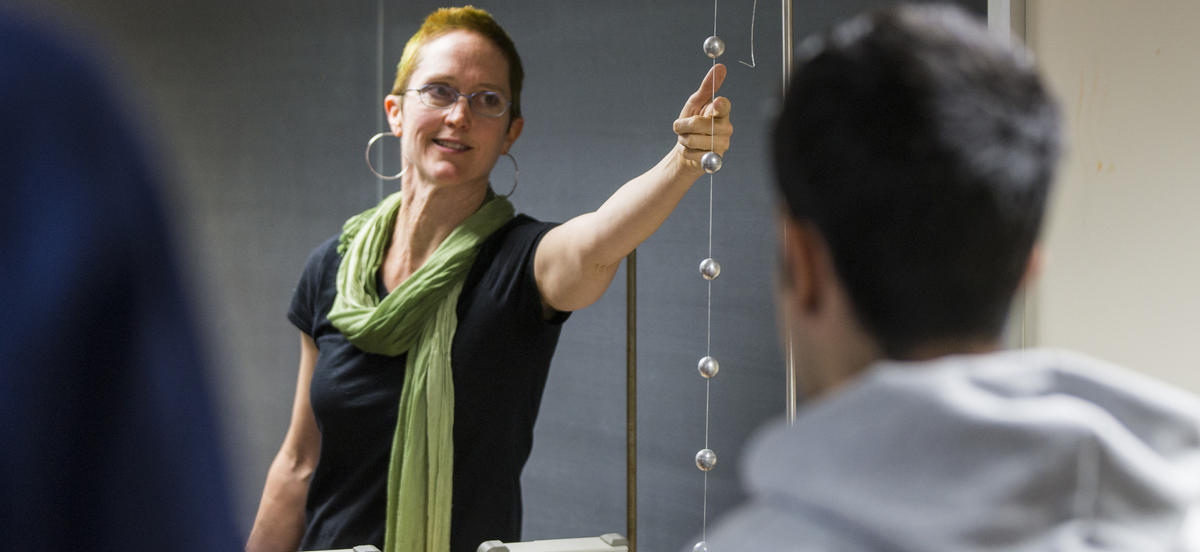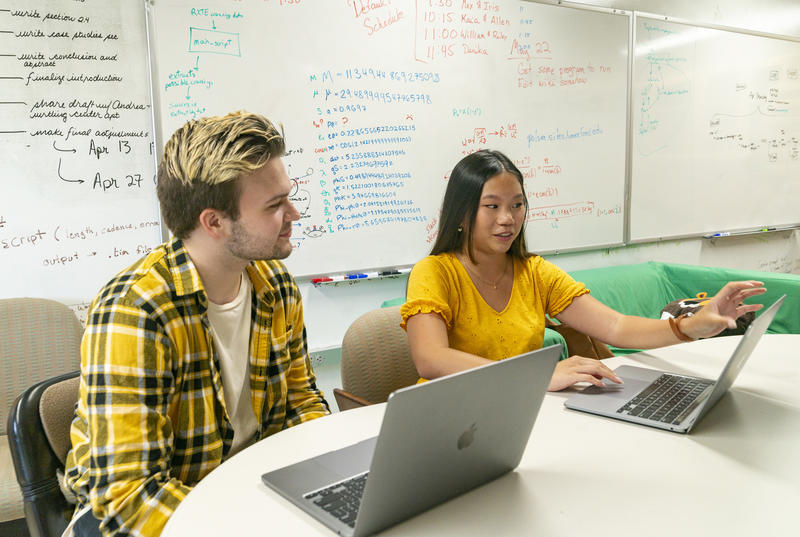NASA Invites Haverford Physicist Andrea Lommen and Team to Investigate Novel Space Navigation Program

Professor Andrea Lommen teaching in her Physics 213 course, "Waves and Optics." Photo by Patrick Montero.
Details
Lommen, a professor of physics and astronomy, will spend the next six months in an initial concept development project that will incorporate work by Haverford seniors.
Haverford's senior thesis program is an unmatched opportunity for students across disciplines to identify, design, and conduct a research project and then analyze and present their conclusions.
And four recent physics and astronomy students — Nathaniel Ruhl ’22, Noah Schwab ’22, Romana Hladky ’22, and Seamus Flannery ’23 — will see their senior thesis work applied to a NASA program by a team of scientists that includes their thesis advisor, Professor of Physics and Astronomy Andrea Lommen. Two current students, Allen Gift ’25 and Kaia Reenock ’26, are working this fall on the next phase of the work.
“The agency's Small Business Innovation Research (SBIR) and Small Business Technology Transfer (STTR) programs invest in a diverse portfolio of American small businesses and research institutions to support NASA’s future missions,” says Lommen. “Our proposal, one of 300 that NASA wants to learn more about, is to launch a small spacecraft to demonstrate our navigational system. Ruhl, Schwab, and Hladky made a significant contribution in designing the system to work around the Earth.” Reenock and Gift are now extending the system for operation around the moon.
The small business with which Lommen collaborates is ASTER Labs, Inc., led by Suneel Sheikh. ASTER Labs concentrates on engineering consultation for the aerospace and medical industries. Lommen, Ruhl, and Schwab received funding both from the NASA Neutron Star Interior Composition Explorer (NICER) program and Haverford’s Astrophysics Travel Fund in order to develop their basic algorithm.
The method Lommen’s group developed is called Occulting X-ray Source Navigation, or OXNAV. “It’s a relatively simple concept. If you’re orbiting a planet, there will be distant stars that get occulted every time you go behind the planet,” Lommen says. “If you know the exact moment a star gets occulted, you also know your position at that time. That’s how we calculate position in space.”
“When it gets fun,” Lommen laughs, “is when you try to work out the geometry of that situation. That’s what Nate and Noah did for their theses. And now Kaia is working that out for the topography of the moon.”
Using data from NICER, an X-ray telescope perched atop the International Space Station (ISS), Lommen’s team demonstrated they could determine the station’s location within a few kilometers without the aid of any of the station’s onboard tracking systems.

Ruhl, Schwab, Hladky, and Flannery’s work assumed their spacecraft would be orbiting a planet with an atmosphere, meaning it’s actually the atmosphere that eclipses the star. Now, Lommen’s team is extending the program to include a rocky, lumpy body with no atmosphere, like the moon. Reenock and Gift’s work this fall involves doing 3D calculations using a model of the moon’s terrain from NASA’s Jet Propulsion Laboratory. They are also mining the databases of previous X-ray telescopes for serendipitous occurrences of eclipses that will allow the team to test its updated method.
Jenn Gustetic, director of early stage innovation and partnerships for the Space Technology Mission Directorate at NASA’s headquarters in Washington, says the agency has a key role to play in growing the aerospace ecosystem in our country. “Through these early-stage small business awards, we are inviting more innovators into this growing arena and helping them mature their technologies for not only NASA’s use but also for commercial impact,” she says.
More than a quarter of the selected companies are women-owned, veteran-owned, disadvantaged, and/or HUBZone small businesses. Some 30% of the selected proposals, including the one from Haverford, are from first-time NASA SBIR/STTR recipients. “We are proud to work alongside the small businesses and research institutions in need of government investment,” says Gynelle Steele, deputy program executive for NASA's SBIR/STTR program at NASA Headquarters. “This program enables NASA to nurture pioneering ideas from a diversity of innovators across the country that may not attract the initial private industry funding needed to thrive.”
NASA selected SBIR/STTR Phase I proposals to receive funding by judging their technical merit and commercial potential. ASTER Labs has contracted with Haverford for $22,500 to explore the potential of the novel navigation technology. Based on their progress during Phase I, ASTER Labs and Haverford plan to submit a proposal for Phase II funding to develop a prototype.
Students who worked on this research previously have been supported in part by the Astrophysics Travel Fund, which was made possible by a generous donation to Haverford from the parent of an astronomy and physics alum. The fund allowed Lommen’s team to travel to the American Astronautical Society Meeting in Breckenridge, Colorado, where they presented the first stage of their work.
Lommen points out that even if the team’s SBIR Phase II proposal isn’t selected after completing the initial Phase I effort, the very process of authoring it helps students better understand both their research and what’s required in order to persuade NASA to support the design and launch of a mission.




